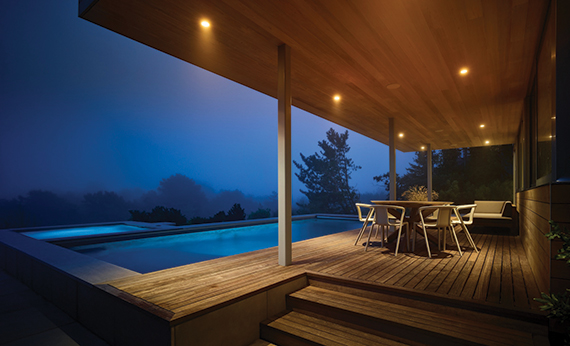Trending
East End architecture is all about connections
Fred Stelle’s aesthetic draws top clients — including Calvin Klein — </br>who look for classic design

Fred Stelle was never drawn to postmodern architecture, with its “sentimental, backward-looking” nostalgia for simpler times. “I’m always looking forward,” says Stelle.
In his 40-year career, the well-known architect has had ample opportunity to bring his modernist philosophy to beachfront homes in the Hamptons, offering dramatic dunescape views through sweeping clear glass windows, as well as to projects as far away as Spain, Switzerland and China — all of which he initially hand-draws.
Since founding the firm now known as Stelle Lomont Rouhani Architects in 1985, he and his Bridgehampton-based team have been involved in many high-profile endeavors, among them Calvin Klein’s house in Southampton, racking up many awards along the way.
“I would say that 90 percent of our work is waterfront,” says Stelle. “I think it’s a combination of what the clients want and what we’ve shown ourselves to be adept at doing.”
Stelle and his wife, Bettina, live in Sag Harbor and are parents of three grown children. The Real Deal spoke with him recently about his career and design trends in the Hamptons.

Fred Stelle
What interested you in architecture in the first place? As with many things in my life, I can’t really answer that question. My father was an engineer who worked in the city. I grew up on a dirt road in Bedford, N.Y. I was always making things, doing things and building things in my head. I went to high school in Concord, New Hampshire, at St. Paul’s. There were a lot of architecture courses there. The school has a beautiful campus. What were then the new buildings were designed by Edward Larrabee Barnes, who lived down the road from me. When the college counselor asked me what I planned to do, I said architecture.
You went to work for Barnes when you started your career, working on buildings on Yale University’s Old Campus. How has architecture changed since then? Certainly, the computer has changed everything. It’s made the whole production end of architecture so much cleaner. You can make infinite replications of different approaches to a problem. It’s a design tool, but it’s not a solution or a design. The only solution is what is between your ears.
Information technology has made architecture a global practice. We have projects all over the place because of the internet. People can find your information globally.
When did you start working in the Hamptons? I moved here in 1984. I had a practice in the city. I came out here because I wanted to choose the way I lived over my most opportune place to work. I didn’t want to have a city life. I wanted to be able to experience nature and be able to be outdoors. Certainly, New York is a much more fertile place for architects than Bridgehampton.
How has working in the Hamptons changed? It’s changed demographically. The clientele has gotten younger. It’s such a desirable area for second-home owners.
What’s happened out here is modern architecture has become very prevalent for private houses. I rarely see private houses going up that are not modern.
 There is also the cost factor. Today, even the cost of rentals is very expensive. We all know stories about share houses where there have been eight, nine or 10 kids in a house that has four bedrooms. They end up selling shares in the bedrooms. That side of transiency in the share houses has earned a bad reputation.
There is also the cost factor. Today, even the cost of rentals is very expensive. We all know stories about share houses where there have been eight, nine or 10 kids in a house that has four bedrooms. They end up selling shares in the bedrooms. That side of transiency in the share houses has earned a bad reputation.
What are some of the most successful components of design in the Hamptons? Obviously high quality. That’s the foundation of it all.
In terms of the work we do, I think the key component is the connection to the outdoors. That is why people come out east, to experience the outdoors. Houses that don’t connect to the outdoors are not successful.
The family room-kitchen, where the kitchen is the centerpiece of the house, is very accommodating. Swimming pools are of secondary importance.
Certainly, good value for the money is important, too. Buyers need to feel they are getting something that really has value.
What are the biggest obstacles to Hamptons projects? Certainly money. I think the cost of construction is really crazy. It’s based partially on demand and partially on the lack of resources. We live on a peninsula. All of our labor for the work that gets done comes from the west. The same with the material. It is pretty limited. I think the demand for the high-quality labor and materials drives the price up. Part of our job is to align people’s expectations with the cost.
I think the other big obstacle is the permitting process. As the towns become more populated, there is more sensitivity to the need to protect what makes real estate valuable. Part of the value of being out here is to have wonderfully preserved beaches, forests, fields and farmland.
One thing that is frustrating is the quality of service. There is just a lot of work. Not everybody can get access to the person they want to do the work that has to be done, whether it’s a builder, a plumber, a gardener, a nanny or whomever. There is a lot of competition for service.
What are you working on now? Right now is a funny time. It reminds me a little bit of ‘08. In ‘08 the phone basically stopped ringing, but we had a lot of backlog. We never slowed down. I’m looking at 2016 and we had three new projects come in, which is not a lot for us. In 2015, we had 16 projects come in.
Are there fewer projects overall in the Hamptons? When I talk to real estate people, I hear it has been slower for the last few years. But I also hear things have changed as of January 1. There is new energy in the market. The uncertainty of the election is gone. Whatever you think of our president, he’s generally perceived to be business-friendly and real estate-friendly.
What is the typical price range for the homes you design? We don’t do spec houses. The typical 3,000- to 4,000-square-foot house is going to end up costing $3 million to $4 million to build. We have other projects. We’re doing a project now that will be $35 million when it’s done.
What is ahead for 2017? We’re making sure we’re being very productive and that we take care of the clients we have. We’re not afraid to take on things that might be different in scope or nature than we would normally do. We’d take on the renovation of a house, where we might leave part of the house and do some modern additions. I love doing that. I don’t believe in throwing houses away. I think it’s more interesting to have a house end up telling a story of its existence. It’s a lot of fun. If it wasn’t, I wouldn’t be doing it.




